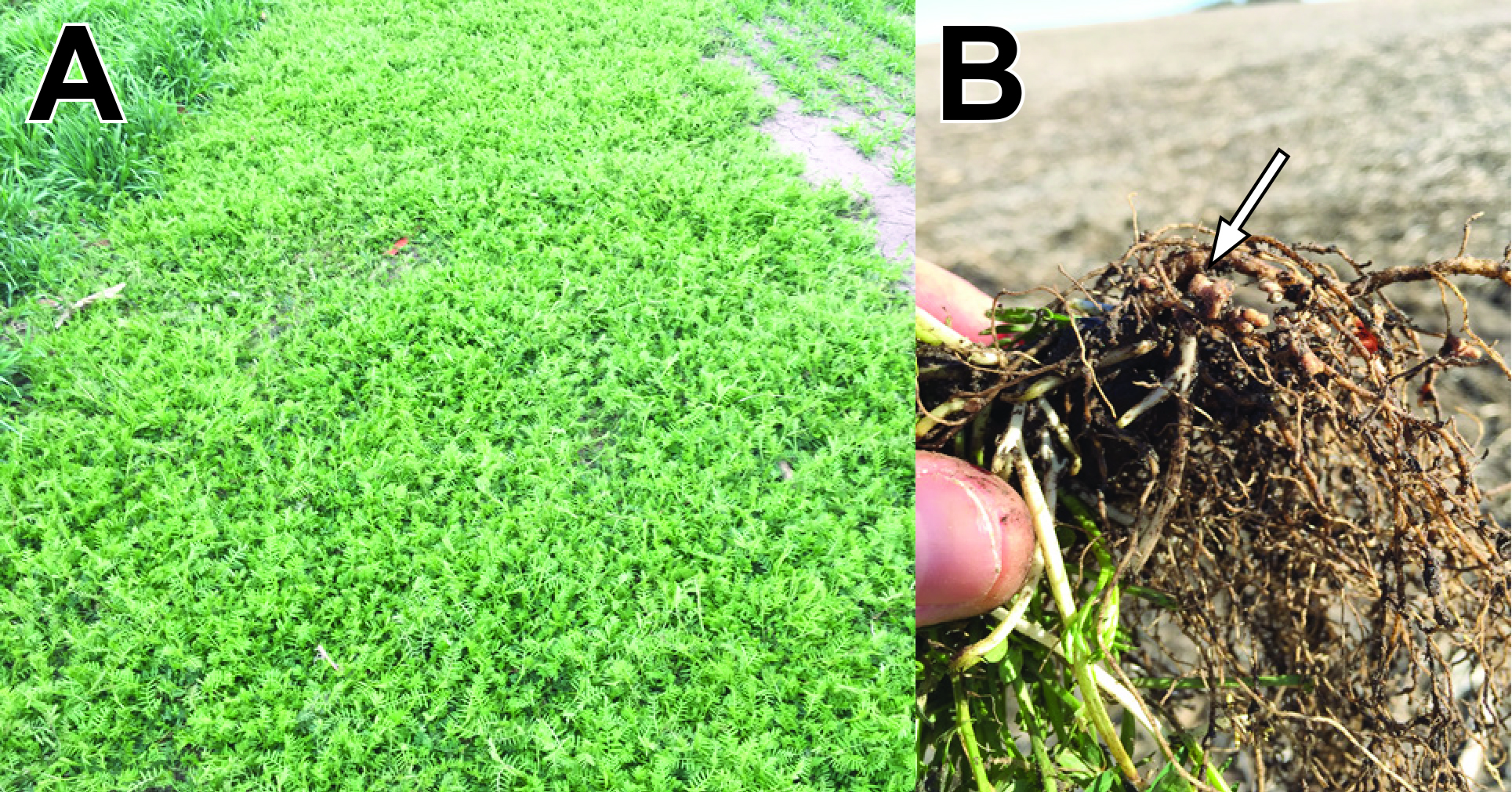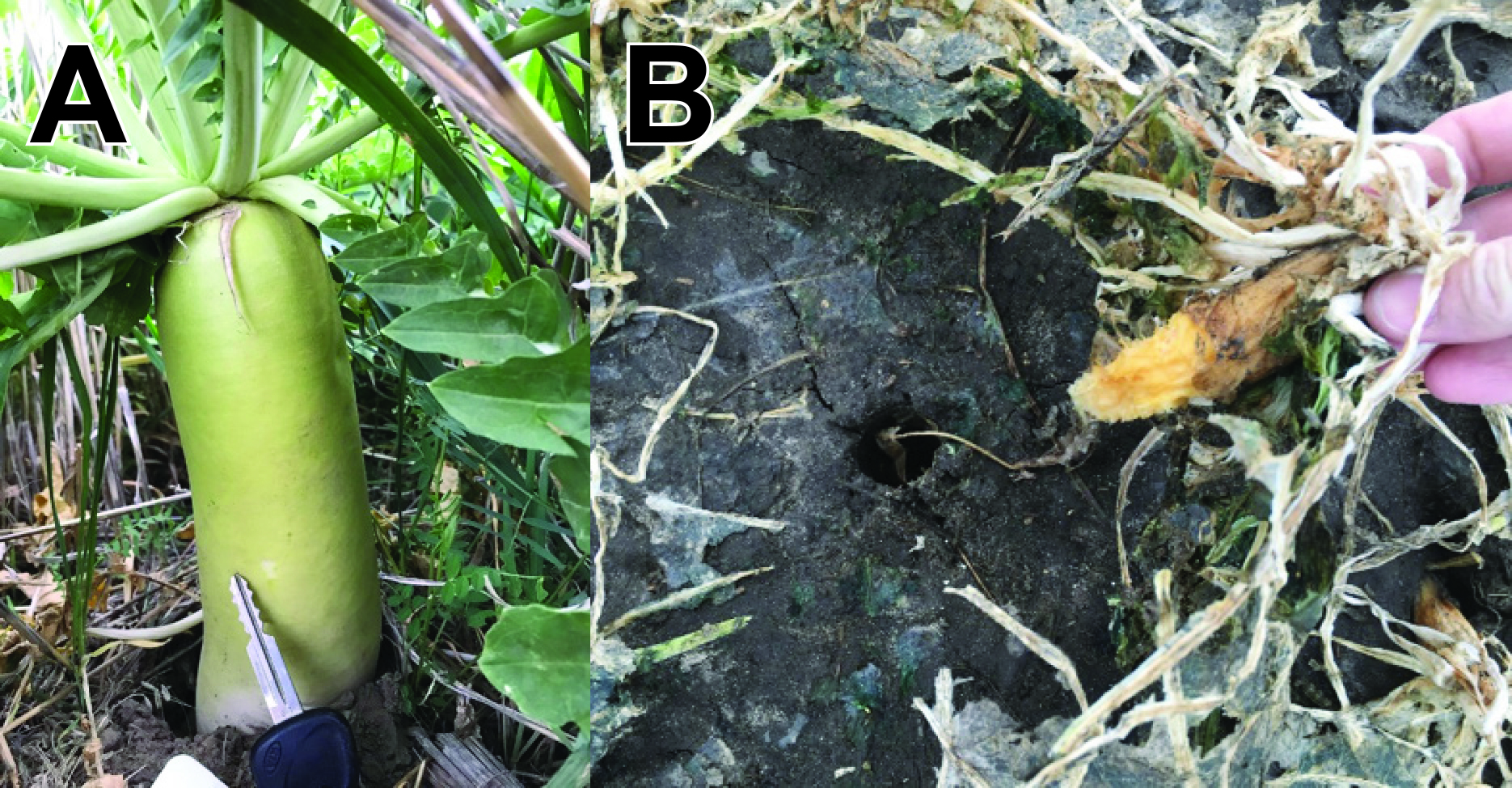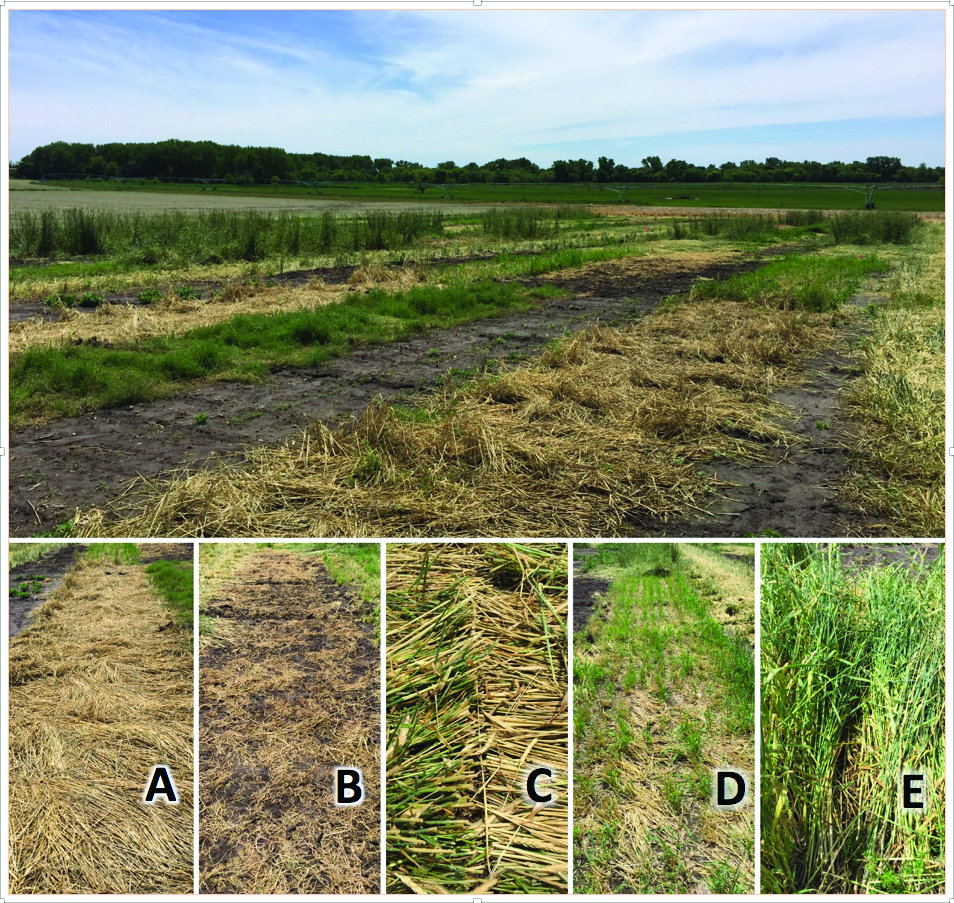

Joshua J. Miller, Postdoctoral Research Associate, Department of Plant Pathology
Katja Koehler-Cole, Postdoctoral Research Associate, Department of Agronomy and Horticulture
Rodrigo Werle, Nebraska Extension Cropping Systems Specialist, West Central Research and Extension Center
Daren D. Redfearn, Nebraska Extension Forage and Crop Residue Specialist, Department of Agronomy and Horticulture
When deciding how best to use cover crops, it is important to consider the ultimate goal. Is it to increase soil organic matter, increase nutrient availability to subsequent crops, reduce soil compaction, supply forage for livestock, and/or suppress weeds? Answering these questions will help identify the cover crops that offer the best chance of success for meeting the goal. Primarily, cover crops are used to enhance soil conservation, nutrient cycling and supply, and weed control. However, these benefits vary based on the species of cover crop that is planted, so it is important to select the crop type that will fit into your current cropping system, as well as provide the desired outcome.
It is important to note that yield decreases to the subsequent commodity crop have sometimes been observed with the use of cover crops, from incomplete termination, soil moisture loss, and/or nutrient immobilization. All of these can be minimized with proper selection and management of your cover crop.
Cover crops can be used to meet soil conservation goals, specifically from wind and water erosion. Wind erosion potential in the drier regions of the Great Plains is high in late winter and early spring. Winter cover crops, especially grass species with their extensive root systems, can reduce wind erosion by holding the soil in place as well as protecting the soil surface. Water erosion can also be reduced because cover crops increase infiltration. For example, tap-rooted brassicas, such as radish and turnips, can grow through compacted soil layers and leave behind macropores, channeling precipitation to deeper soil layers. Additionally, the aboveground biomass reduces the impact of rainfall, thereby preventing soil runoff (Blanco-Canqui et al., 2015). In a single-year demonstration plot at the Eastern Nebraska Research and Extension Center located near Mead, Neb., even the winter-killed radish cover crop prevented soil erosion from torrential spring rains compared with the no cover crop check plot (Figure 1).

Figure 1. Effect of cover crop on soil erosion (May 11, 2016).
Cover crop residues add organic matter to the soil, but so do crop residues such as cornstalks and leaves. Many farmers ask, “My fields have plenty of residue from corn and soybeans, so why do I need cover crops?” First, living cover crops are better at holding soil in place than residue and are capable of capturing sunlight and carbon at a time when the field would otherwise be bare. Secondly, cover crop residue has higher quality [more nitrogen (N) in relation to carbon (C)] than corn and soybean residue. Soil microbes that decompose organic material use the C for energy, but also need N for building proteins for growth. For residues with a C:N ratio greater than 24:1, microbes must take N from the soil to be able to degrade this residue, resulting in N immobilization (commonly referred to as N tie-up). Cover crops are terminated before they enter reproductive stages and concentrate N in their reproductive tissues. Their C:N ratio is between 10 and 25, which is much lower than corn stover. Thus, once cover crops are terminated, crop residues decompose more quickly. Nutrients bound in the terminated cover crops are then returned to the soil where they can be taken up by the next crop. Nitrogen released from high-N cover crops, such as legumes, cereal grasses, and brassicas, can also be used by soil microbes to break down organic materials high in C, such as corn stover. Using high-C materials, such as crop residues, followed by high-N materials, can improve soil physical properties over several years.
Growing cover crops can also feed the soil microbes and improve microbial activity when there is no residue available. One possible improvement is enhanced soil mycorrhizal activity. Mycorrhizal fungi interact with roots to form a symbiotic relationship. The fungi increase the volume of the root system and increase the plant’s ability to search out and take up nutrients. Mycorrhizae also secrete glomalin, a water-insoluble protein that acts as a glue to bind soil particles and other matter to form aggregates. All of these effects of cover crops enhance the soil’s ability to function like a living organism.
When soil is left bare, nutrients are subject to physical and chemical reactions that result in the movement of those nutrients out of the soil profile. Nitrogen is extremely vulnerable to losses through leaching when it is present in nitrate form. Nitrate has a negative charge, so it does not bind to the negatively charged soil particles. When water moves through the soil profile, nitrate can be carried with it. Most cover crops roots are in the topsoil and will utilize N from this layer, preventing it from leaching to deeper soil layers. Additionally, deep-rooted cover crops can reverse some leaching, since they scavenge nutrients from deeper in the soil. When cover crops decompose, these nutrients are released and become available for the next crop. Grasses and brassicas are the most suitable cover crop species for taking up N that would otherwise be leached. For example, non-leguminous cover crops reduced nitrate leaching by 50 percent compared with a fallow rotation in irrigated cropping systems (Quemada et al., 2013).
Cover crops also play an important role in improving the availability of phosphorus in the soil (Villamil et al., 2006). Although phosphorus is not prone to leaching, it is often unavailable to plants because it resides in the soil in its inorganic form. Mycorrhizal fungi associated with cover crops are efficient scavengers of phosphorus and can help absorb the nutrient from the soil into an organic form in the plant. The organic form is then more readily available for the subsequent crop.
Cover crops can aid in nutrient cycling through N fixation. This process is unique to leguminous crops because of a symbiotic relationship with rhizobia bacteria. Legume roots in soybean, clover, and vetch can be infected with Rhizobium that form nodules (Figure 2). These nodules act as an exchange site where atmospheric N is accumulated and converted to plant available ammonium. In exchange, the plant supplies carbohydrates and proteins. In some instances, cover crop N fixation can add N to a cropping system. After four years of planting either late-maturing soybean or sunn hemp as a cover crop in a winter wheat-grain sorghum rotation, total soil N increased by more than 220 lbs N/ac (Blanco-Canqui et al., 2011) compared with plots with no cover crops.

Figure 2. Hairy vetch cover crop (A) and a close-up of nodulated hairy vetch roots (B); nodules indicated by the arrow.
The anticipated soil improvements resulting from cover crop management can take several years to happen. In addition to providing other benefits of cover crops, interest in using cover crops as a grazed or mechanically harvested forage has increased. This is because grazing seems to be the quickest way to recover some of the production costs associated with planting a cover crop. In the western Corn Belt, numerous opportunities exist for providing additional forage planted following grain crop production. For many of the spring cover crop species that are late-summer planted with the intention of providing soil cover, light to moderate grazing can begin in early October without reducing any soil improvements provided by the cover crop. Similarly, the fall-planted winter cover crop species will provide the same benefits under moderate spring grazing.
A well-established and managed cover crop stand can be an effective component of an Integrated Weed Management Program. Cover crops may directly compete with weeds for water, light, and nutrients, physically hinder weed seedling emergence and establishment, and release allelochemicals (substances that inhibit the growth of other species). After termination, cover crop residue can provide additional weed suppression. Research by Teasdale et al. (1991) showed that weed suppression was directly correlated with soil area covered and biomass of cover crop residue. Fall-planted cover crops that grow through the winter and spring are effective at reducing the population of winter annual weeds such as marestail, henbit, tansymustard, and field pennycress, and can also suppress early season summer annual weeds such as kochia and giant ragweed (Figure 3). Solely, cover crops are not a solution for weed management, but when combined with herbicides and other strategies, they may enhance overall weed control in cropping systems.

Figure 3. Impact of cover crops on weed suppression. Winter fallow (A) versus drilled cereal rye (B) after harvest of corn silage (pictures taken on mid-April; counting square in the center of the picture represents a 1 ft2 area). Note the winter annual weed pressure in the absence of a cover crop.
Although there are documented benefits of using cover crops, adoption of the practice in the Corn Belt remains relatively low. One of the primary concerns growers have about cover crops is water utilization. Cover crops take up soil water that could be used by the primary crop. This is a particular concern in regions of limited precipitation and in dryland cropping systems. Studies have shown that summer planted cover crops in wheat-fallow systems can reduce the available soil water to the subsequent wheat crop and ultimately reduce wheat yields (Nielsen and Vigil, 2005). A strategy to mitigate yield losses is to terminate cover crops early to allow soil water recharge before planting of the primary crop (Blanco-Canqui et al., 2015). In regions with high precipitation, cover crops have been documented to eliminate excess water on poorly drained soils (Kahimba et al., 2008), reduce runoff, increase water infiltration, and improve other physical processes (Blanco-Canqui et al., 2012).
A good rule of thumb is to invest as much time in planning the management of the cover crop as the management of the primary crop. Choosing the right cover crop depends on the objectives you hope to achieve. Different cover crops provide benefits based on their physiology, growth, and production. Legume cover crops can reduce N fertilizer demands for the following crop. Radishes and sudangrass can alleviate compaction issues in fields (Figure 4). Many of the small grains and other cover crop species are used as nutrient scavengers to sequester excess nutrients.

Figure 4. Oilseed (tillage) radish planted after wheat harvest (A). Large macropore from rotting radish root (B).
The cropping system determines when and how to plant and terminate cover crops (Figure 5). Planting too late may prevent the cover crop from accumulating enough biomass to provide the desired benefits. Terminating too late may result in nutrient immobilization or soil water deficits that could be detrimental to the subsequent commodity crop. Cover crops can be terminated chemically or mechanically. Incomplete termination can occur with both methods, especially when cover crops are in advanced growth stages. In an ongoing study near Mead, Neb., different termination methods of cover crops significantly impacted the development of subsequently planted corn and soybean (Figure 6).

Figure 5. Illustration of a corn-soybean rotation incorporating a grass and leguminous cover crop (Courtesy of Justin McMechan).

Figure 6. Cover crop termination study conducted at the UNL Eastern Nebraska Research and Extension Center near Mead, Neb. Cover crops were planted in the fall and terminated at different times prior to corn or soybean planting. Species and termination methods used were: (A) early termination (mid-April) of cereal rye with glyphosate; (B) early termination of hairy vetch with glyphosate; (C) roller/crimper terminated cereal rye; (D) chopped cereal rye; (E) “green planting” through living cereal rye.
Before planting cover crops, it is important to rethink your herbicide program. Certain herbicides applied to crops can injure cover crops, even when they are planted several months after the herbicide was applied. Brassicas, such as radish, seem more vulnerable to pesticide damage. Additionally, herbicide selection may restrict use of certain cover crops or eliminate the opportunity to graze cover crops, so selecting appropriate herbicides is critical.
Cover crops may improve crop management by improving soil structure and function, nutrient cycling and weed suppression. Since they are crops, it is important to plan and manage them as you would for any cropping system. There are other resources available that provide additional information about specific cover crop types and what benefits they provide. Contact your Nebraska Extension Educator for more information on incorporating cover crops into your cropping system. Do not be afraid to try – “It is only through failure and through experiment that we learn and grow”–Isaac Stern.
Midwest Cover Crops Council (MCCC): http://www.mccc.msu.edu/
Nebraska On-Farm Research Network: http://cropwatch.unl.edu/farmresearch
Sustainable Agriculture Research and Education (SARE): http://www.sare.org/Learning-Center/Topic-Rooms/Cover-Crops
UNL CropWatch: http://cropwatch.unl.edu/cover-crops
Blanco-Canqui H., Claassen M., Presley D. (2012) Summer cover crops fix nitrogen, increase crop yield, and improve soil–crop relationships. Agronomy Journal 104:137–147.
Blanco-Canqui H., Shaver T.M., Lindquist J.L., Shapiro C.A., Elmore R.W., Francis C.A., Hergert G.W. (2015) Cover crops and ecosystem services: Insights from studies in temperate soils. Agronomy Journal 107:2449–2474.
Kahimba F., Ranjan R.S., Froese J., Entz M., Nason R. (2008) Cover crop effects on infiltration, soil temperature, and soil moisture distribution in the Canadian Prairies. Applied Engineering in Agriculture 24:321–333.
Nielsen D.C., Vigil M.F. (2005) Legume green fallow effect on soil water content at wheat planting and wheat yield. Agronomy Journal 97:684–689.
Quemada M., Baranski M., Nobel-de Lange M., Vallejo A., Cooper J. (2013) Meta-analysis of strategies to control nitrate leaching in irrigated agricultural systems and their effects on crop yield. Agriculture, ecosystems & environment 174:1–10.
Teasdale J.R., Beste C.E., Potts W.E. (1991) Response of weeds to tillage and cover crop residue. Weed Science:195–199.
Villamil M., Bollero G., Darmody R., Simmons F., Bullock D. (2006) No-till corn/soybean systems including winter cover crops. Soil Science Society of America Journal 70:1936–1944.
This publication has been peer reviewed.
Nebraska Extension publications are available online at http://extension.unl.edu/publications.
Extension is a Division of the Institute of Agriculture and Natural Resources at the University of Nebraska–Lincoln cooperating with the Counties and the United States Department of Agriculture.
University of Nebraska–Lincoln Extension educational programs abide with the nondiscrimination policies of the University of Nebraska–Lincoln and the United States Department of Agriculture.
© 2017, The Board of Regents of the University of Nebraska on behalf of the University of Nebraska–Lincoln Extension. All rights reserved.